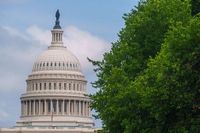As the United States enters the third week of its government shutdown, the crisis has not only set records but also exposed deep rifts and anxieties within the political establishment. With 20 days and counting, this shutdown has become the longest full government closure in American history, surpassing even the infamous 35-day partial shutdown of 2018-2019. Yet, despite the mounting consequences for federal employees and ordinary citizens, a solution remains elusive, trapped in a web of political calculations, ideological divides, and raw fear of backlash from party bases.
According to The Hill, the central drama playing out in Washington is not just between Republicans and Democrats, but within the Democratic Party itself. Many Democratic senators, particularly those from centrist or swing-state backgrounds, privately admit they are terrified of angering their party’s most liberal activists. One anonymous Democratic senator confessed, “People are going to get hammered if they vote for the House-passed bill to reopen the government and keep it funded through Nov. 21.” Another insider, also speaking anonymously, put it even more bluntly: “We would have enough votes to reopen the government if people were not terrified of getting the guillotine.”
This fear is not abstract. Grassroots Democrats, frustrated with the Trump administration, have been demanding an uncompromising fight from their representatives. Millions recently took to the streets in “No Kings” demonstrations, protesting both the president and the government’s closure. The message from the base is clear: don’t reopen the government without securing meaningful concessions, especially on health care. For many Democratic senators, the threat from their own activists looms even larger than that from their Republican counterparts.
So far, only three members of the Democratic caucus have broken ranks to vote for reopening the government: Senators John Fetterman of Pennsylvania, Catherine Cortez Masto of Nevada, and Angus King of Maine (an Independent who caucuses with Democrats). Senator Jeanne Shaheen of New Hampshire recently signaled her unease by voting to advance an $852 billion defense funding bill, making her the fourth Democrat to show public discomfort with the party’s hard-line stance. Yet, these moves have drawn sharp criticism from progressive activists. Andrew O’Neill, national advocacy director at Indivisible, called the votes “baffling” and a “mistake,” insisting, “This was not a good faith effort from Republicans to end the shutdown with bipartisan negotiations. It was GOP political theater, and these three Democrats joined right in.”
Senator Fetterman, however, defended his decision, emphasizing his concern for military families who might otherwise have to rely on food banks. “I voted yes to pay our service members. That’s service members over party. That’s not baffling to me,” he told The Hill.
Meanwhile, Senate Majority Leader John Thune (R-S.D.) continues to push for votes on the House-passed continuing resolution, hoping to peel off at least five more Democratic votes to finally reopen the government. But the reality, as one Democratic senator told The Hill, is grim: “Are there enough Democrats to join Republicans to reopen the government? Not in the near term.” The senator added, “There is no bipartisan conversation that’s anything but bulls---.”
The stakes are not just political. As reported by Punchbowl News, roughly 750,000 federal employees have been furloughed, with 4,200 already laid off and the threat of another 10,000 looming. Federal workers are about to miss their first full paycheck on October 24, covering the period from October 4 to October 18. The Congressional Federal Credit Union is scrambling to offer “furlough solutions” to affected employees, but the pain is spreading. Air traffic controllers may soon stop showing up for work, threatening chaos in the nation’s aviation system. Small business and farm loans are frozen, and vital nutrition programs like WIC and SNAP are at risk, with states like New Jersey warning that November benefits may not be available if the shutdown continues.
Despite the urgency, the House of Representatives has been out of session for more than a month. Speaker Mike Johnson has declared he won’t reconvene the chamber until the shutdown ends, leaving committees frozen and legislative business at a standstill. President Donald Trump, for his part, has mostly stayed out of the fray, reportedly feeling that the White House is winning the political battle. He is scheduled to leave for Asia on October 24, creating what some see as a narrow window for Congress to get his attention and possibly broker a deal.
Senate Minority Leader Chuck Schumer has been almost pleading for Trump to step in and negotiate an extension of the enhanced Obamacare premium subsidies, which are set to expire. Yet Trump has resisted, leaving Senate and House leaders to run the shutdown strategy. With the start of open enrollment for health insurance on November 1 fast approaching, some Democrats see that date as a potential “off-ramp” — a moment to declare political victory and allow the government to reopen, even if they don’t achieve a legislative win on healthcare. The idea is to force Republicans to “own” the coming premium hikes and coverage losses, a gamble that could shift blame as the crisis deepens.
But this strategy is fraught with risk, particularly for Democrats in swing states. Senator Jon Ossoff of Georgia, considered one of the most vulnerable Democrats up for reelection in 2026, has voted ten times against the House-passed funding bill and recently voted against advancing a bipartisan defense bill. As one Democratic insider explained, Ossoff’s dilemma is clear: “Do I vote to open the government up and get crushed and can’t raise a single dollar of low-dollar money or do I vote to shut the government down and get $3 million [from online fundraising]?”
Online fundraising and social media have become powerful motivators for senators, with strategists noting that the ability to raise money from the liberal base often outweighs other considerations. Emma Lydon, managing director of P Street (associated with the Progressive Change Campaign Committee), argued that voting to reopen the government without securing health care concessions “would be out of step with what the American people want.” She accused Republicans of trying to “dismantle the ACA brick by brick” and insisted that Democrats “stand up for people’s health care, that stands up for our democracy and that’s what they’re doing now.”
Yet, as the shutdown drags on, some centrist Democrats are growing restless. They’re being forced to vote repeatedly on a “clean” continuing resolution, even as leaders in both parties have yet to meet to address the core issue of rising health care costs. One senator lamented, “I don’t think the leadership is talking to each other and I don’t see how we get a deal unless the people in charge decide they’re going to sit down and negotiate. People in the rank-and-file are doing a lot of talking. It would be nice if our leaders were also talking.”
As the days tick by and the consequences mount, the government shutdown has become a test not just of political will, but of the ability of leaders to navigate the pressures of their own parties and the real-world needs of the nation. Whether a path out of the deadlock will emerge before further damage is done remains the question on everyone’s mind.


